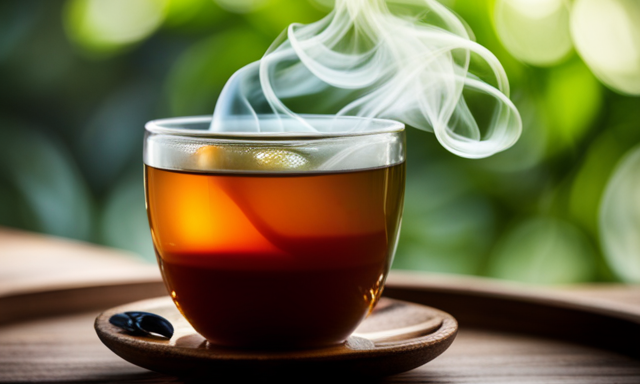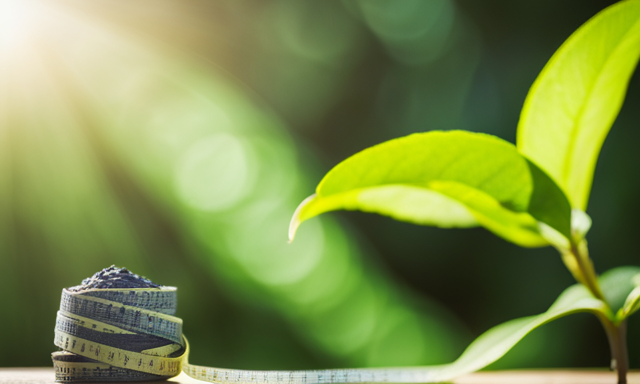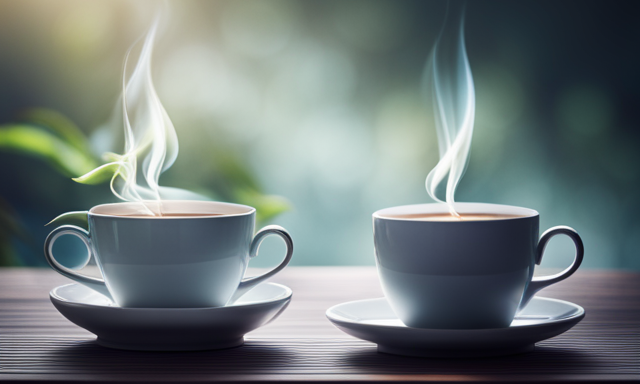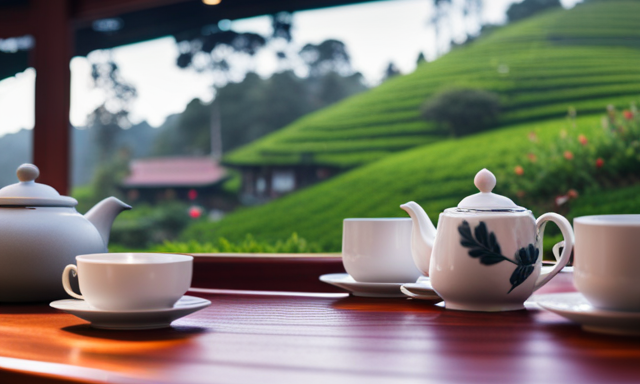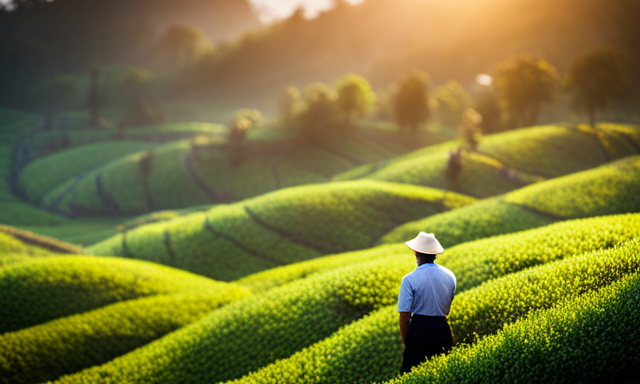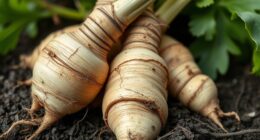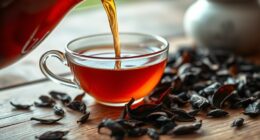As the saying goes, ‘A cup of tea is a cup of tranquility.’ And when it comes to oolong tea, that tranquility is taken to a whole new level. Allow me to introduce you to the world of oolong tea, a beverage steeped in rich history and delightful flavors.
Oolong tea originates from China, where it has been enjoyed for centuries. With its unique production process, oolong tea strikes a perfect balance between the robustness of black tea and the delicate nuances of green tea. The leaves are partially oxidized, resulting in a complex flavor profile that is floral, fruity, and sometimes even slightly nutty.
In this article, we will explore the origins of oolong tea, delve into its production process, and discuss the different varieties available. I will also share brewing techniques, health benefits, and how oolong tea is deeply ingrained in Chinese culture.
Whether you’re a tea aficionado or simply curious about this exquisite beverage, join me on this journey to discover the wonders of oolong tea.
Key Takeaways
- Oolong tea is rich in antioxidants and provides numerous health benefits, including weight management, improved cardiovascular function, and reduced risk of heart disease.
- Oolong tea has cultural and culinary significance in Chinese culture, being used in tea ceremonies and traditional Chinese medicine. It pairs well with seafood, spicy cuisine, cheese, and desserts, making it a versatile beverage.
- Oolong tea is widely available and can be found in specialty tea shops, online retailers, health food stores, and grocery stores. Different types of oolong tea offer varying flavors and benefits.
- While oolong tea is generally safe to consume, it is important to be aware of potential side effects and interactions with medications.
The Origins of Oolong Tea
The origins of oolong tea can be traced back to the mountains of China, where it was first cultivated and cherished for its unique flavor profile. With its historical significance dating back centuries, oolong tea holds a special place in Chinese culture. It has been enjoyed by emperors and scholars alike, who appreciated its delicate and complex taste.
Oolong tea is known for its partially oxidized leaves, which give it a distinct flavor that falls between black and green tea. Its flavor profile can range from floral and fruity to toasty and nutty, depending on the specific variety and the level of oxidation. This cultural significance has led to the development of a meticulous production process that carefully preserves the tea’s delicate flavors.
Now, let’s delve into the fascinating journey of oolong tea’s production.
The Production Process
During the production process, the leaves undergo a meticulous transformation, evolving from vibrant green to a rich, complex infusion that captivates the senses. This transformation is achieved through a combination of production techniques and tea oxidation. Here are four key elements of the production process that contribute to the unique qualities of oolong tea:
-
Withering: The leaves are spread out and left to wither, allowing moisture to evaporate and enzymes to activate.
-
Oxidation: The withered leaves are gently rolled, rupturing their cell walls and initiating oxidation.
-
Fixation: Heat is applied to halt the oxidation process and preserve the desired level of oxidation.
-
Rolling: The leaves are rolled into tight, curled shapes, which enhances their flavor and aroma.
The careful execution of these steps results in oolong tea’s distinct flavor characteristics.
Now, let’s explore the captivating taste experience that awaits.
Flavor Characteristics
When it comes to flavor characteristics of oolong tea, two key points that stand out are the floral and fruity notes. Oolong tea often exhibits a delicate and pleasant floral aroma, reminiscent of orchids or jasmine. Additionally, it can offer a subtle sweetness and complexity that adds depth to the overall taste profile.
These flavors combine to create a sophisticated and enjoyable sensory experience for tea enthusiasts.
Floral and fruity notes
With its delicate blend of floral and fruity flavors, oolong tea takes your taste buds on a captivating journey through a garden of aromatic sensations. The floral aromas of oolong tea are reminiscent of blooming flowers, filling the air with their sweet and enchanting scents.
As you take a sip, the tea reveals its complex flavor profiles, offering a symphony of fruity notes that dance on your palate. The taste of oolong tea can range from subtle hints of peach and apricot to more pronounced flavors of lychee and passionfruit. Each sip is a delightful surprise, as the tea unfolds its layers of fruity goodness.
The combination of floral and fruity elements creates a harmonious balance that is both refreshing and invigorating. Transitioning into the subsequent section about ‘subtle sweetness and complexity,’ oolong tea’s captivating flavors are further enhanced by its subtle sweetness and intriguing complexity.
Subtle sweetness and complexity
The subtle sweetness and complexity of oolong tea’s flavor profile add a sophisticated allure to each sip. It’s this delicate balance that sets oolong tea apart from other types of tea.
The subtle sweetness dances on the tongue, leaving a lingering sensation that’s both refreshing and satisfying. As the flavors unfold, the complexity of oolong tea becomes apparent, with layers of nuttiness, floral undertones, and hints of fruitiness intertwining harmoniously.
Each cup is a journey of taste, as the flavors evolve and reveal themselves with every sip. The interplay of these elements creates a truly unique and captivating experience.
Transitioning into the subsequent section about different varieties of oolong tea, one can explore the diverse range of flavors that each variety offers.
Different Varieties of Oolong Tea
Indulge in the rich and velvety flavors of various oolong tea varieties, and experience a taste so exquisite it’ll transport you to a world of sensory delight.
Oolong tea comes in different oxidation levels, resulting in a wide range of flavor profiles that cater to every palate. Here are some varieties to entice your taste buds:
-
Tie Guan Yin: This lightly oxidized oolong offers a delicate floral aroma and a buttery smoothness that lingers on the tongue.
-
Da Hong Pao: With a medium oxidation level, this oolong boasts a roasted flavor with hints of caramel and a satisfyingly toasty finish.
-
Oriental Beauty: Known for its unique bug-bitten leaves, this highly oxidized tea delivers a sweet, honey-like taste and a fruity aroma.
-
Milk Oolong: Grown in Taiwan, this lightly oxidized tea surprises with its creamy texture and a subtle milky flavor.
Now that you’re familiar with the different varieties, let’s delve into the art of brewing techniques to unlock the full potential of oolong tea.
Brewing Techniques
When it comes to brewing oolong tea, two key factors to consider are water temperature and steeping time.
The optimal water temperature for brewing oolong tea is typically around 190°F (88°C), which allows the leaves to unfurl and release their flavors gradually.
As for steeping time, oolong tea can range from 30 seconds to several minutes, depending on personal preference and the specific oolong tea variety.
It’s also worth noting that using the right teaware, such as a gaiwan or a ceramic teapot, can enhance the overall tea experience and bring out the nuanced flavors of oolong tea.
Water temperature and steeping time
To achieve the perfect infusion of flavor, it’s crucial to pay careful attention to the temperature of the water and the duration of steeping when brewing oolong tea.
The water temperature plays a significant role in extracting the delicate aromas and flavors of oolong tea. For lighter oolongs, such as green oolong, water heated to around 180°F is ideal, while darker oolongs, like roasted oolong, benefit from water heated to around 200°F.
Steeping time also varies depending on the type of oolong. Lighter oolongs generally require shorter steeping times of around 3-4 minutes, while darker oolongs can be steeped for 5-7 minutes to fully develop their robust flavors.
When it comes to oolong tea, precision is key in order to achieve the perfect balance of taste and aroma.
Now, let’s move on to teaware recommendations for an enhanced tea experience.
Teaware recommendations
When it comes to brewing the perfect cup of oolong tea, water temperature and steeping time are crucial factors. Now that we have covered that, let’s move on to another important aspect of enjoying oolong tea: the teaware. Having the right teaware can enhance your tea-drinking experience and bring out the flavors of the tea. There are several reputable teaware brands that offer a wide range of options, such as porcelain teapots from Jingdezhen or Yixing clay teapots from Taiwan. Each material has its own unique qualities, with porcelain being lightweight and easy to clean, while Yixing clay is known for its ability to retain heat. Whichever brand or material you choose, investing in high-quality teaware will elevate your oolong tea experience to new heights. Speaking of elevating, let’s now delve into the health benefits of oolong tea and discover how it can improve our well-being.
Health Benefits of Oolong Tea
Oolong tea offers a multitude of health benefits that make it an excellent addition to any wellness routine. It’s rich in antioxidant properties, helping combat free radicals and promote overall health and well-being.
Furthermore, oolong tea is known to aid in weight management by boosting metabolism, making it a great choice for those seeking to shed a few pounds.
With its refreshing taste and numerous health benefits, oolong tea is truly a powerhouse beverage.
Antioxidant properties
Immerse yourself in the rich, fragrant world of oolong tea, where antioxidants weave a tapestry of health and vitality, embracing your senses with a symphony of flavors.
Oolong tea is not only a delightful beverage, but it also offers numerous antioxidant benefits that contribute to heart health. The unique combination of catechins, theaflavins, and thearubigins found in oolong tea work together to reduce the risk of heart disease by promoting healthy blood pressure levels and reducing cholesterol. These powerful antioxidants also help to prevent the formation of plaque in the arteries, improving overall cardiovascular function.
Transitioning into the subsequent section about weight management and metabolism boost, oolong tea’s antioxidant properties extend beyond heart health, making it a valuable addition to any wellness routine.
Weight management and metabolism boost
Indulging in this aromatic brew can support your weight management goals and give a boost to your metabolism, helping you achieve a healthier and more vibrant lifestyle. Oolong tea is not only a delicious beverage, but it also has properties that can aid in weight loss. Thanks to its thermogenic effect, oolong tea can help increase your body’s calorie-burning capabilities. This means that by incorporating oolong tea into your daily routine, you may be able to shed those extra pounds more effectively. To better understand the potential benefits of oolong tea for weight management, let’s take a closer look at the following table:
| Benefit | Description |
|---|---|
| Increased Energy | Oolong tea can provide a natural energy boost, helping you stay active and burn more calories. |
| Appetite Suppression | The tea’s natural compounds can help curb cravings and reduce your overall calorie intake. |
| Fat Oxidation | Oolong tea has been shown to enhance the body’s ability to burn fat, aiding in weight loss. |
With these weight management benefits in mind, let’s delve into the rich history of oolong tea in Chinese culture, where it has been cherished for centuries.
Oolong Tea in Chinese Culture
In Chinese culture, Oolong tea is like a magical elixir that transports you to a serene garden filled with the delicate fragrance of blooming flowers. It holds a significant place in Chinese tea ceremonies, where it’s revered for its calming and meditative qualities.
Oolong tea has been a part of traditional Chinese medicine for centuries, believed to promote overall well-being and balance in the body. Its unique combination of antioxidants and natural compounds make it a popular choice for those seeking a healthier lifestyle. The Chinese have long recognized the benefits of oolong tea for its ability to aid digestion and boost metabolism.
This rich and flavorful tea pairs beautifully with a variety of foods, enhancing the flavors and creating a harmonious balance. Transitioning into the next section about pairing oolong tea with food, it’s fascinating to explore the incredible culinary possibilities that await.
Pairing Oolong Tea with Food
To truly savor the full culinary experience, you’ll want to explore the delectable world of pairing oolong tea with a wide range of foods. Oolong tea, known for its unique flavor profile, can enhance the taste of various dishes when paired correctly. Here are four delightful combinations to consider:
-
Seafood: The delicate and floral notes of oolong tea complement the natural sweetness of seafood, creating a harmonious balance of flavors. Try pairing it with grilled shrimp or steamed fish for a delightful culinary experience.
-
Spicy Cuisine: Oolong tea’s slightly smoky and earthy undertones can help temper the heat in spicy dishes. Enjoy it alongside spicy Szechuan cuisine or flavorful Indian curries to enhance the overall taste.
-
Cheese and Desserts: The rich and complex flavors of oolong tea pair beautifully with creamy cheeses like brie or camembert. Additionally, its natural sweetness and aromatic qualities make it an excellent accompaniment to desserts like fruit tarts or chocolate truffles.
-
Asian-inspired Dishes: Oolong tea’s origins in Chinese culture make it a perfect match for Asian-inspired dishes. Consider pairing it with dim sum, stir-fried noodles, or dumplings for a truly authentic experience.
When enjoying oolong tea, it’s essential to be mindful of its potential side effects and interactions with medications.
Now, let’s explore where to find and buy oolong tea.
Where to Find and Buy Oolong Tea
When it comes to discovering the perfect source for your next cuppa, the search for the finest oolong tea can take you on a delightful adventure of taste exploration. The good news is that oolong tea is widely available, and you can find it in various places.
One of the best options is to visit specialty tea shops or online retailers that specialize in high-quality teas. These places often have a wide selection of oolong teas, ranging from lightly oxidized to heavily oxidized varieties.
Additionally, health food stores and some grocery stores may carry oolong tea as well. When buying oolong tea, it’s important to consider the flavors you prefer and the benefits you seek, as different oolong teas offer different flavor profiles and health benefits.
Frequently Asked Questions
How much caffeine does oolong tea contain?
Oolong tea contains approximately 30-50 mg of caffeine per 8-ounce serving. It can slightly elevate blood pressure due to the caffeine content, but its antioxidant properties may help promote digestion.
Can oolong tea help with weight loss?
Oolong tea offers a surprising benefit: it can boost metabolism. Studies have shown that drinking oolong tea can increase calorie burning by up to 10%. It’s a natural and delicious way to support weight loss goals.
Is oolong tea suitable for people with sensitive stomachs?
Oolong tea benefits those with sensitive stomachs as it has a soothing effect. With a wide range of flavor profiles, it can be light and floral or rich and toasty, offering a delightful experience to the palate.
Can oolong tea be steeped multiple times?
Yes, oolong tea can be steeped multiple times. In fact, it’s one of the few teas that can be re steeped without losing its flavor. This is due to its unique leaf characteristics.
Does oolong tea have any side effects?
Oolong tea has numerous benefits, including promoting mental health. However, it is important to note that excessive consumption can lead to side effects such as insomnia, headaches, and heartburn.
Conclusion
In conclusion, Oolong tea is a delightful and unique beverage that tantalizes the taste buds with its enchanting flavors. Its origins and production process add a touch of mystique to this tea, making it a true gem.
From its fragrant floral notes to its smooth and velvety texture, Oolong tea is a sensory experience like no other. So why not embark on a journey of flavors and indulge in the captivating world of Oolong tea? It’s like taking a sip of nature’s finest elixir.

